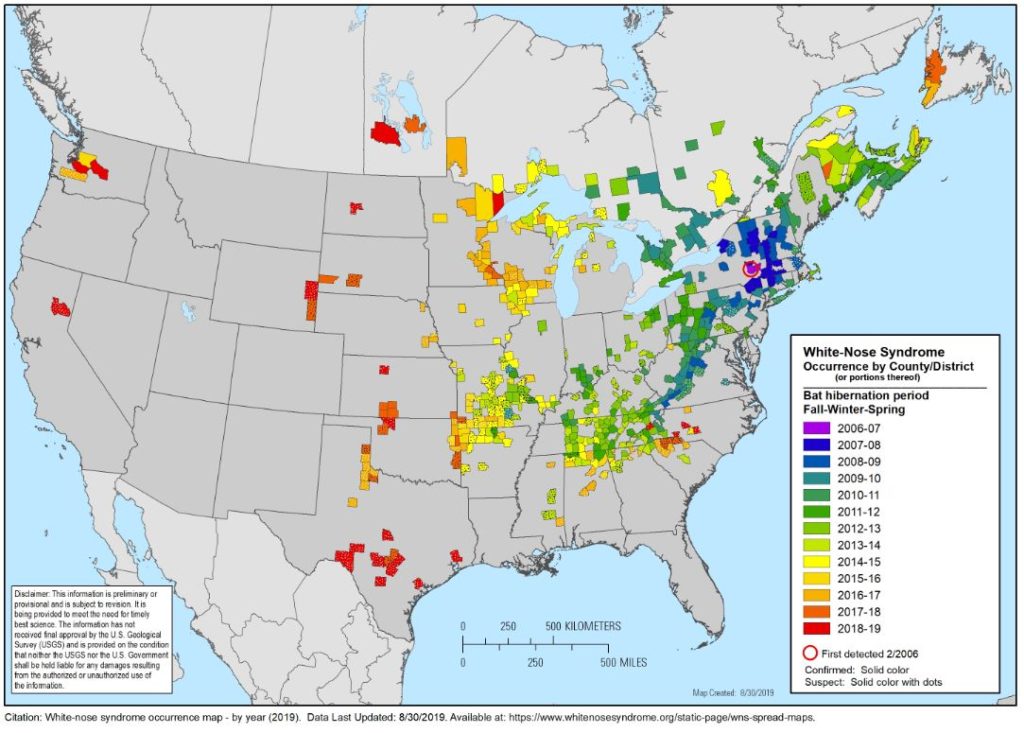
Report sick bats or suspected WNS in Washington here: Report sick or dead bats
Learn about Clean Caving / Decontamination Protocols here: Decontamination Information
Learn about White-nose syndrome in Washington State here: Washington Department of Fish and Wildlife
White-nose syndrome has killed millions of bats and has been found in four counties in bats in Washington State.
Cascade Grotto members are required to observe the National Decontamination Policy.
More information about the international effort can be found here: whitenosesyndrome.org
Timeline of WNS in Washington State:
Note: Some bat species are affected by white-nose syndrome while others may only carry the fungus that causes white-nose syndrome (Pseudogmynoascus destructans [Pd]), and not show any symptoms of the disease.
April 2019
- A little brown bat or Yuma myotis (species are difficult to distinguish visually) captured near North Bend in King County tested positive for white-nose syndrome.
- Four little brown bats or Yuma myotis (species are difficult to distinguish visually) that were found near Cle Elum in Kittitas County in April tested positive for white-nose syndrome. WDFW received the positive test results in August. This is the first confirmation of white-nose syndrome east of the Cascade Range in Washington.
March 2019
- Five little brown bats or Yuma myotis (species are difficult to distinguish visually) found in King County tested positive for white-nose syndrome.
- A western long-eared myotis (Myotis evotis) found in King County tested positive for white-nose syndrome. This is the first time this species has been confirmed with the disease in North America.
- A little brown bat found in Pierce County tested positive for white-nose syndrome. This is the first case of white-nose syndrome in Washington outside of King County.
May 2018
- Guano (bat poop) samples collected from a little brown bat and Yuma myotis colony near Issaquah in King County tested positive for the fungus that causes white-nose syndrome.
- Environmental samples collected under a bridge frequented by bats in Lewis County tested positive for the fungus that causes white-nose syndrome.
- Three little brown bats or Yuma myotis (species are difficult to distinguish visually) found near North Bend in King County tested positive for white-nose syndrome.
April 2018
- Four little brown bats or Yuma myotis (species are difficult to distinguish visually) found near North Bend in King County tested positive for the fungus that causes white-nose syndrome. The bats showed symptoms of the disease, but researchers were unable to confirm if they were positive. Samples collected from the bat roost also tested positive for the fungus that causes white-nose syndrome.
- Eight Yuma myotis captured near North Bend in King County tested positive for the fungus that causes white-nose syndrome. The bats showed symptoms of the disease and researchers confirmed seven of the bats tested positive for the fungus that causes white-nose syndrome. In addition, samples collected from the bat roost also tested positive for for the fungus.
- A little brown bat or Yuma myotis (species are difficult to distinguish visually) found near Renton in King County was submitted to the Department of Health for rabies testing. The bat tested negative for rabies, but positive for white-nose syndrome.
- A little brown bat or Yuma myotis (species are difficult to distinguish visually) found near Maple Valley in King County was submitted to a wildlife rehabilitator associated with Raindancer Wild Bird Rescue. The bat tested positive for white-nose syndrome.
- A little brown bat or Yuma myotis (species are difficult to distinguish visually) found at a maternity colony near North Bend in King County tested positive for white-nose syndrome.
March 2018
- A Yuma myotis found near North Bend in King County tested positive for white-nose syndrome.
January 2018
- A little brown bat found near Seattle in King County tested positive for white-nose syndrome.
- A little brown bat found near North Bend in King County, the same location as the bats confirmed with white-nose syndrome in April 2017, tested positive for white-nose syndrome.
- A little brown bat and Yuma myotis found in King County were submitted to the Department of Health for rabies testing. The bats tested negative for rabies, but positive for the fungus that causes white-nose syndrome.
July 2017
- Guano (bat poop) collected from under the same bridge sampled in July 2016 tested positive for the fungus that causes white-nose syndrome.
May 2017
- Guano collected from a maternity roost (where female bats give birth and nurse babies) near North Bend in King County tested positive for the fungus that causes white-nose syndrome.
- Researchers collected samples from bats at Mount Rainier National Park in Lewis County. Lab results showed two little brown bats and two Yuma myotis tested positive for the fungus that causes white-nose syndrome.
April 2017
- A Yuma myotis (Myotis yumanensis) and a little brown bat were found on separate occasions near North Bend in King County. Lab tests confirmed these bats had white-nose syndrome.
July 2016
- Guano (bat poop) collected from under a bridge frequented by bats near North Bend in King County tested positive for the fungus that causes white-nose syndrome.
March 2016
- A little brown bat (Myotis lucifugus) was found alive on a trail by a hiker near North Bend in King County. A veterinarian from Progressive Animal Welfare Society (PAWS) noticed clinical signs of white-nose syndrome, including dehydrated, wrinkled wings. Testing at the USGS National Wildlife Health Center confirmed the bat had white-nose syndrome.
- A silver-haired bat (Lasionycteris noctivagans) found near Seattle in King County tested positive for the fungus that causes white-nose syndrome.
*Source:
https://wdfw.wa.gov/species-habitats/diseases/bat-white-nose#
